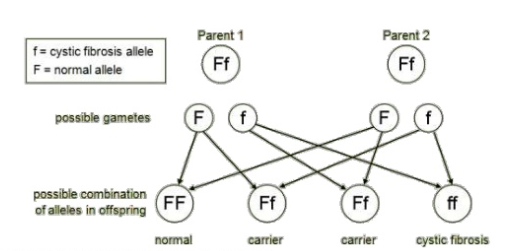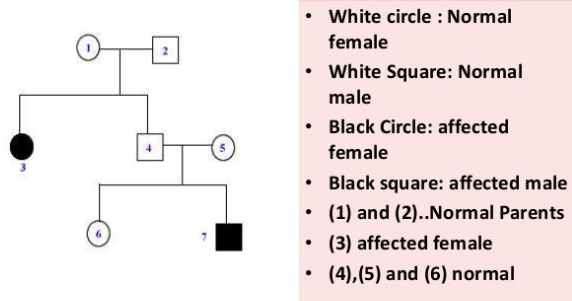Alleles
Key Terms
| Key term | Definition |
| Chromosome | Found inside the nucleus, they are long and thin structures which are made from DNA molecules. The contain genetic information. |
| Gene | Region of DNA that contains instructions to create an order of amino acids in a protein. |
| Allele | Different versions of a gene. |
| Dominant | If there is a dominant allele, then it will always be expressed. (represented by higher case) |
| Recessive | If there is a recessive allele, it will only be expressed if there are two copies of the same recessive allele (represented by lower case) |
| Homozygous | Someone with identical alleles for a specific gene. |
| Heterozygous | Someone with different alleles for a specific gene. |
| Genotype | Group of alleles that determine an organism’s characteristics. |
| Phenotype | When genotypes are influenced by the environment and is expressed |
| Gamete | Sex cell. Male sex cell = sperm. Female sex cell = ovum. |
| Zygote | Fertilised egg with 46 chromosomes. |
Monohybrid Inheritance
Punnett squares can be used to look at combinations of genetic crosses in single genes. This would show the possible combination of offsprings that will be can be produced - you would be able the calculate the probability of obtaining a certain characteristic.
Example 1
Whether someone has hairy ears or non-hairy ears is controlled by a single gene with 2 alleles: hairy and non-hairy.
The hairy allele is dominant and is shown as H. The non-hairy allele is recessive and is shown as h. If someone with hairy ears (Hh) reproduces with someone with non-hairy ears (hh), here is the punnett square to represent this information:
| H | h | |
| h | Hh | hh |
| h | Hh | hh |
Direct Proportion: Half of the offspring would have hairy ears (Hh), and the other half will not have hairy ears (hh).
__Probability: __The probability of offspring being Hh is 50%. The probability of offspring being hh is 50%
Ratio: The ratio of the genotypes HH:Hh is 1:1
Example 2
Whether someone has sickle cell anemia is determined by a single gene with 2 alleles: S and s. If someone has a single allele of ‘s’, they will be a carrier. If someone has two alleles of ‘ss’, they will have sickle cell anemia. If someone has two alleles of ‘SS’, they will be safe from the disease. If two carriers of sickle cell anemia have a child together, here is the punnett square to represent this information:
| S | s | |
| S | SS | Ss |
| s | Ss | ss |
Direct Proportion: A quarter of the offspring will be safe from sickle cell anemia (SS), a quarter of the offspring will have sickle cell anemia (ss), and half the offspring will be carriers (Ss).
Probability: The probability of offspring being Ss is 50%. The probability of offspring being SS is 25%. The probability of offspring being ss is 25%.
Ratio: The ratio of the genotypes Ss:SS:ss is 2:1:1. This is another type of diagram that shows the genotype and phenotype.
Family Pedigree
This is a family pedigree which allows you to determine the phenotype within a family. This family pedigree shows the information of 3 generations. The key on the right is used to determine whether the individual is affected or not.
- How many chromosomes does a fertilised egg have?
- 46
- Where are chromosomes found?
- Your answer should include: Inside / Nucleus
- What is the genotype of someone that suffers from sickle cell anemia?
- ss

